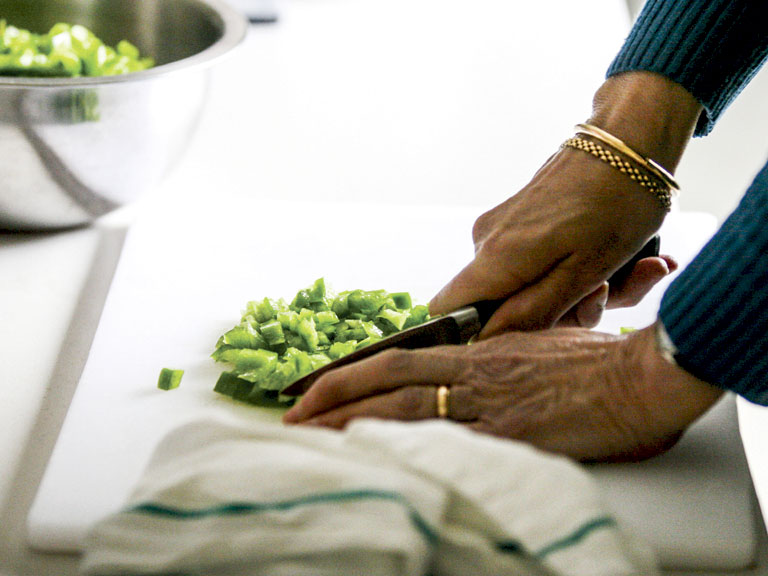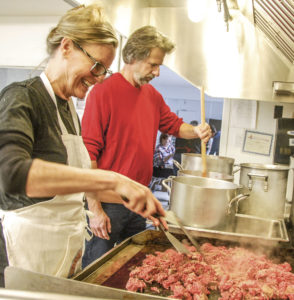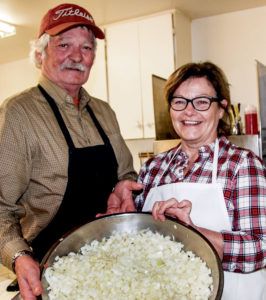County News
Now we’re cooking

Food to Share looking to expand, and a find a permanent home to put down their ladle
They are the drought’s unseen casualties. County food banks rely on excess produce from local farmers to support their clients. But when these growers’ harvests are stressed by adverse conditions such as the drought experienced last summer, that supply of excess vegetables is compromised, forcing foodbanks and families to scramble.

Volunteer Heather Ford cooks up burger for spaghetti sauce alongside Food to Share founder Glen Wallis at the Wellngton Legion.
These organizations were particularly hard hit this past winter—forcing the Food to Share project to dig into its operating dollars to buy food.
“We stepped in and helped,” said Glen Wallis of Food to Share. “We bought about 1,800 pounds of food for the Christmas hampers.”
He has recently submitted applications for funding to keep the project cooking—with ambitions to expand its reach and perhaps become a year-round service and one day find a permanent cooking facility.
Last year, Food to Share raised $10,000. This year, Wallis hopes to raise double that amount, $20,000.
BY THE NUMBERS
So far the project has taken in 20,000 pounds of food from local growers. Some of it is processed, including 2,000 pounds of tomatoes made into sauce and chili. Some is donated raw and distributed frozen, including 2,000 pounds of peas.
Each week, through the winter, a group gathers— typically on a Tuesday—at one of about half-dozen kitchens across the County to prepare, process and package food for distribution to the local foodbanks. Food to Share draws upon a volunteer list of more than 168 people.
They produce about 100 meals during their cooking sessions each week.
But mounting this moveable cooking feast has become a significant logistical challenge. All of the cooking, processing and packaging supplies and much of the produce is stored at Wallis’s Cherry Valley home. While Wallis greatly appreciates community groups such as the Legion in Wellington offering their kitchen and facilities for these cooking sessions, the entire ef-fort is dependent on his availability and capacity.
“A permanent kitchen would be ideal,” said Wallis.“Currently every time we cook I have to pack every-thing we need for that session in my car, drive it to the cooking location. Afterwards I must remember to takee verything back and put it into storage. It’s an enormous hassle.”

Bob Stock and Cheryl Vigar carve up a mess o’ onions for spaghetti sauce.
He would be happy as a first step to find an alternate facility to store the food and supplies
“I have two freezers now and tonnes of dry goods,” explained Wallis. “I need the ability to store fresh pro-duce when it comes in. It has been great that we have been successful—but we are hobbled by a lack of a permanent home base.”
He believes a number of groups and businesses could benefit from a commercial kitchen.
“People who do canning, food service and catering in the County could really use a commercial kitchen for businesses to rent and community groups could use,” said Wallis.
He would also like to extend the Food to Share project to become a year-round operation.
“Our program currently runs in the fall and winter. I see the possibility that it runs all year long. To do that we would need to buy more food.”
Which brings Wallis back to funding the Food to Share project. He has submitted grant applications to the Stark Family Fund and one from the Community Foundation and one from the municipality—for the use of the kitchen at the arena.
Food to Share has enjoyed generous support from County Farm Centre, Wellington United Church, the Athol Town Hall and the Wellington Legion. None have the room to provide it with space to store food.
Wallis is hoping to announce Food to Share fundraising event taking place at the Crystal Palace later this year.
Next month, Food to Share will offer cooking classes at Hillier Town Hall. Wallis is confident that his organization will overcome the logistical issues. Working with the food banks each week, he understands the important role it plays in terms of improving food security in the County.
“It is still working well,” said Wallis. “It’s still expanding.”

Comments (0)